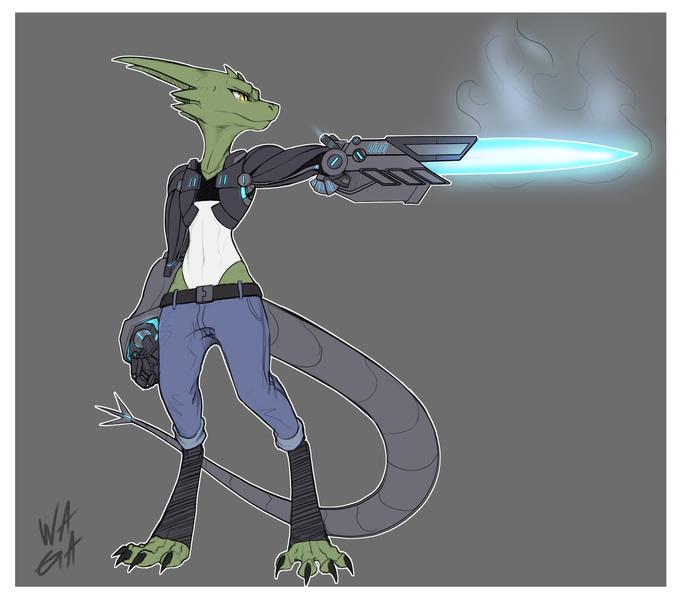Kobolds
Confirmed 34,349
Part of a series on Dungeons and Dragons. [View Related Entries]
Kobolds
Part of a series on Dungeons and Dragons. [View Related Entries]
| Navigation |
| About • Origins • Spread • Examples in Dungeons & Dragons • Kobolds in Video Games • Search Interest • External References • Recent Images • Recent Videos |
About
Kobolds are a race of fantasy creatures that can be found in many works of fiction, notably Dungeons & Dragons, created around 1967 and officially published in 1987 by Forgotten Realms. They are often depicted as small and weak, relying on their wits, large numbers and traps to fight their foes.
Origins
Kobolds originated in Germanic folklore as mischievous household spirits who would help with chores, but hide farm tools and objects around homes, as well as trick people.[1] They were depicted as temperamental and often desired food from their hosts. They have also been called spirits of the caves or mines. The metal "cobalt"[2] was named after them, and it is believed that miners at the time conflated the foul-smelling poisonous fumes from the material with the mischievous spirits. Kobolds would later be adapted to fit the setting of the first Dungeons and Dragons books as goblin-like monsters, later spreading to other fantasy franchises.

Spread
In 1974, kobolds appeared in the first Dungeons & Dragons roleplaying guide as small, weak humanoids that compensated for their physical weakness with cunning and traps. They are depicted as dog-like and labeled as goblinoids from the first edition to the second edition, but from the third edition onwards, they've been depicted as more reptilian and lizard-like. They can be found in the service of dragons inside caves. In later editions, they've become player characters,[3] with many systems no longer confining them to the niche of subterranean minions or limiting them to any one alignment.

Examples in Dungeons & Dragons
Tucker's Kobolds
Tucker's Kobolds refer to the kobolds controlled by a DM named "Tucker," originally referenced in issue #127 of Dragon Magazine (1987) in an editorial about encounter building.[4] The kobolds became infamous for their tenacity and resourcefulness. In the editorial, the author describes various tactics the kobolds would use to terrorize the mid-level party, despite being nothing more than the base kobolds that appeared in the monster manual, which are normally considered very weak.


Pun-Pun the Kobold
Pun-Pun the Kobold is a kobold build[5] for Dungeons & Dragons 3.5e that uses various exploits in the system to attain theoretically unlimited power, even going as far as to attain divinity. Many have criticized this build as only being possible using rules as written, pointing out that very few dungeon masters would let a Pun-Pun-like kobold come to fruition.

In The Furry Community
Kobolds are widespread in the furry community as a race for fursonas and original characters. Some view their popularity as part of the overlap between tabletop roleplaying and scaly communities. Due to their goblin-like stature, kobolds are often used in fan art to create shortstack characters.



Yip Yap/Yipyak
Yip yap is a noise many internet users relate to kobolds or joke about kobolds making. In the Forgotten Realms books, "Yipyak" is a variation of draconic spoken by kobolds.[6] It is described to sound similar to the yipping of a small dog. Due to the endearing nature of this, noises such as "yip" and "yap" have become widely associated with kobolds. In 2018, a trend circulated the internet where artists would put their kobold original characters in shirts saying "Wide Hips, Loud Yips" in reference to this.


Kobolds in Japan
Due to a translation error in the original Dungeon & Dragons book in its Japanese release, the mention of them having a dog-like nose and snout in their original appearance was taken to mean that they were dog people in Japan. This was further cemented by their appearance in the popular game Wizardry[7] as dog-like. Examples of these kobolds in popular media include Gengen from the Suikoden series,[8] Kuro from the Dungeon Meshi manga [9] and Polt[10] from Monster Musume, although she is widely considered to be an anthropomorphized monster girl of a kobold rather than a traditional kobold.



Kobolds in Video Games
Kobold Garden
Kobold Garden is an early access virtual pet RPG in which the player plays as a knight who raises and protects a growing community of kobolds.[11] The gameplay has been compared to that of the Chao gardens from the Sonic Adventure games.

Warcraft
Kobolds appear in Warcraft 3 and its MMORPG successor World of Warcraft as commonly encountered enemy creatures. They are portrayed as primitive, rat-like beings who primarily reside in underground caves, relying on candles placed atop their heads to see in the darkness of their dwellings. They speak short phrases of broken English, the most famous of which is "You no take candle!" in reference to their reliance on them.
Search Interest
External References
[3] DnD5e Wiki – Kobolds as PCs
[5] Dandwiki – Pun Pun build.
[6] Forgotten Realms Wiki – YipYak
[10] Monster Musume Wiki – Polt
[11] Itch.io – Kobold Garden
Recent Videos 18 total
Recent Images 144 total
Share Pin







![[DnD] Size Tiny to size Gargantuan IN ONE TURN ! ~ Kobold Godzilla [DnD] Size Tiny to size Gargantuan IN ONE TURN ! ~ Kobold Godzilla](https://i.ytimg.com/vi/pRgLUEXvQJk/hqdefault.jpg)














Comments ( 140 )
Sorry, but you must activate your account to post a comment.
Please check your email for your activation code.